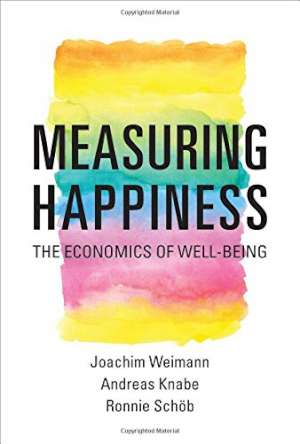24 June 2015
Measuring Happiness: The Economics of Well‑Being
Joachim Weimann, Andreas Knabe and Ronnie Schöb
2015, MIT ress, 224 pages, £16.56
ISBN 9780262028448
Reviewer: Tony Dolphin, Senior Economist, IPPR

When Ken Dodd thanked the Lord that he had been blessed with more than his share of happiness, in his 1964 hit Happiness, he was anticipating economic thinking by about a decade. It was only in the mid-1970s, after Richard Easterlin had published his findings showing rising incomes over time did not appear to lead to increases in average levels of well-being (or happiness) in advanced economies, that economists started to argue people were more concerned about their relative – rather than their absolute – incomes.
Despite the common sense observation that rising incomes do appear to improve people’s lives, even in the richest economies, for example by allowing them to be better educated, to live longer and to experience fuller lives, this view that economic growth does not lead to increased well-being – commonly known as the Easterlin Paradox – has been prominent in the literature for the last 40 years. It has not, though, gone unchallenged and economists have used improved data sets to show higher incomes do, over time, lead to increased life satisfaction even in most advanced countries (the main exceptions being the United States, which may be due to its high degree of income inequality, and Belgium, for which no one appears to have a good explanation).
These challenges to the Easterlin Paradox have, though, in turn also been challenged. Researchers have shown that unemployment has a drastic effect in reducing life satisfaction (over and above its effect through lowering household income); that a person’s health and social environment are also important; and that social contacts and a stable home life increase happiness.
This led to a fashion for calculating well-being indicators as a supplement, or alternative, to GDP. These typically included education levels, measures of health, attempts to quantify social stability and environmental indicators. However, they turned out to be just as unsatisfactory as GDP. No one could come up with an objective weighting system for them; some of the goals conflicted with each other (usually with the environment on one side of the conflict); and, most damning of all, it turned out they did not measure subjective well-being any better than GDP itself.
The authors of this book conclude, therefore, that research over the last 40 years into what determines happiness has shown there is a positive relationship over time between income and life satisfaction, or cognitive well-being (but not affective or emotional happiness); that absolute income levels are just as important for life satisfaction as relative levels; and that real GDP per capita, or median income, is a reasonable indicator of progress.
Their book is most likely to appeal to economists who are vaguely aware of this history of thinking on the subject of happiness but want to know more about the research that lies behind it. And for those who want to delve deeper still, it includes a 35-page long appendix that places happiness studies in the overall context of the evolution of economic research. It is an excellent and thorough review of the literature and, although the authors have many years of expertise in this area between them, they manage to keep an open mind, which makes it all the more readable. This is not a polemic, but a balanced discussion of the issues.
